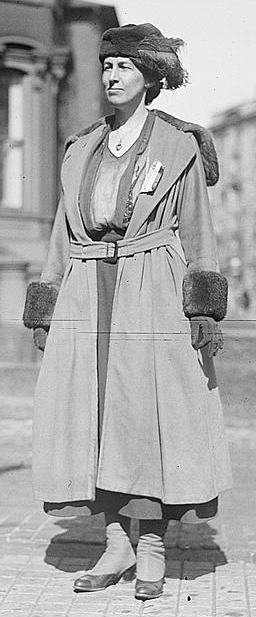Nora Stanton Blatch: Difference between revisions
No edit summary |
m (Text replace - "[[Category:Computers and information processing" to "[[Category:Computing and electronics") |
||
| (5 intermediate revisions by 3 users not shown) | |||
| Line 1: | Line 1: | ||
== | == Biography == | ||
[[Image:Nora Stanton Blatch Barney 1921.jpg|thumb|right]] | |||
<p>Born: September 30, 1883 </p> | |||
<p>Died: January 18, 1971 </p> | |||
<p>Nora Stanton Blatch, an accomplished engineer in her own right, was the wife of [[Lee De Forest|Lee De Forest]], inventor of the triode [[Electron (or Vacuum) Tubes|electron tube]] and the [[Audion Piano|Audion piano]]. Blatch graduated from Cornell University with a degree in civil engineering in 1905 and worked for the New York City Board of Water Supply. </p> | |||
Nora Stanton Blatch | <p>During the courtship of De Forest and Nora Stanton Blatch, Blatch quit her job and enrolled in Columbia University mathematics classes so she could better contribute to De Forest's work. Married in 1908, the couple combined their European honeymoon with collaborative demonstrations of De Forest’s radio equipment to potential buyers. </p> | ||
<p>Nora Stanton Blatch was also devoted to women’s rights, a cause she inherited from her mother, Harriot Stanton Blatch, and her grandmother, Elizabeth Cady Stanton, both prominent in the women’s rights movement in the United States. De Forest had learned to deal with Nora’s activism, but her active work in his lab made him increasingly uneasy. Upon her marriage to De Forest, Nora had thrown herself into learning about electrical engineering. While De Forest wanted a wife who was smart, he also wanted one who was retiring, mild tempered, and who did “womanly” things. Blatch, on the other hand, wanted to supervise operations at his capacitor factory. The couple argued frequently; in early 1909, Blatch, although pregnant, moved out of their home. </p> | |||
[[Category: | <p>De Forest and Blatch were both devoted parents, but De Forest could not understand how Blatch could continue working after motherhood. De Forest criticized Blatch for exhibiting “mentality and calculating ambition” in her efforts to “fill man’s place, to surpass him in his own sphere.” Blatch and De Forest divorced in 1911. Nora Stanton Blatch married marine architect Morgan Barney in 1919 and relocated to Greenwich a few years later, working as a real estate developer and remaining politically active.</p> | ||
[[Category:People and organizations|Blatch]] [[Category:Computing and electronics|Blatch]] [[Category:Electron devices|Blatch]] [[Category:Electron tubes|Blatch]] [[Category:Electronic components|Blatch]] [[Category:Capacitors|Blatch]] [[Category:News|Blatch]] | |||
Revision as of 16:00, 22 July 2014
Biography
Born: September 30, 1883
Died: January 18, 1971
Nora Stanton Blatch, an accomplished engineer in her own right, was the wife of Lee De Forest, inventor of the triode electron tube and the Audion piano. Blatch graduated from Cornell University with a degree in civil engineering in 1905 and worked for the New York City Board of Water Supply.
During the courtship of De Forest and Nora Stanton Blatch, Blatch quit her job and enrolled in Columbia University mathematics classes so she could better contribute to De Forest's work. Married in 1908, the couple combined their European honeymoon with collaborative demonstrations of De Forest’s radio equipment to potential buyers.
Nora Stanton Blatch was also devoted to women’s rights, a cause she inherited from her mother, Harriot Stanton Blatch, and her grandmother, Elizabeth Cady Stanton, both prominent in the women’s rights movement in the United States. De Forest had learned to deal with Nora’s activism, but her active work in his lab made him increasingly uneasy. Upon her marriage to De Forest, Nora had thrown herself into learning about electrical engineering. While De Forest wanted a wife who was smart, he also wanted one who was retiring, mild tempered, and who did “womanly” things. Blatch, on the other hand, wanted to supervise operations at his capacitor factory. The couple argued frequently; in early 1909, Blatch, although pregnant, moved out of their home.
De Forest and Blatch were both devoted parents, but De Forest could not understand how Blatch could continue working after motherhood. De Forest criticized Blatch for exhibiting “mentality and calculating ambition” in her efforts to “fill man’s place, to surpass him in his own sphere.” Blatch and De Forest divorced in 1911. Nora Stanton Blatch married marine architect Morgan Barney in 1919 and relocated to Greenwich a few years later, working as a real estate developer and remaining politically active.
